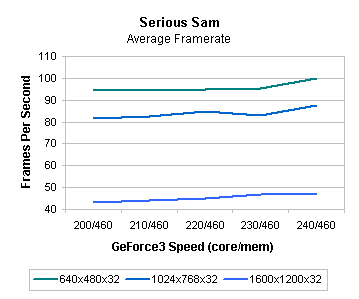NVIDIA GeForce3 Roundup - July 2001
by Matthew Witheiler on July 25, 2001 11:39 PM EST- Posted in
- GPUs
Overclocking the Core
To start things off, we knew that the overclocking capabilities of each GeForce3 card we tested would be different but we didn't know exactly how the GeForce3 chip responded to overclocking. Obviously, in previous tests we found that overclocking both the memory and the core of GeForce3 video cards resulted in faster frame rates but we couldn't say if overclocking one clock on the card held a significant advantage to overclocking the other.
If you recall from our GeForce2 GTS overclocking guide, GeForce2 GTS cards were so memory bandwidth limited that core overclocks in excess of 35MHz provided little to no performance increase. It was only when the memory clock of the card was overclocked that we were able to realize the drastic performance increases that are typically associated with overclocking. This ideally demonstrated the constrained memory bus that the GeForce2 GTS was working with, as even in the stock speed the GeForce2 GTS was limited by the memory architecture of the card.
As you likely recall, the GeForce3 implemented a new memory architecture dubbed Lightspeed Memory Architecture. The new architecture promised to boost memory bandwidth by implementing more efficient methods for data traveling to the memory, which you can read about here.
We hoped that Lightspeed Memory Architecture would bring back the days when overclocking the core actually resulted in a performance increase, even if the memory clock speed was left the same. Not only would this assure us that the GeForce3 makes good use of its 7.36GB/s memory bandwidth, it would also help us determine the best way to overclock the GeForce3 for our roundup.
To begin we overclocked our GeForce3 core while leaving the memory clock the same. We went up in 10MHz increments, going from the stock 200MHz clock speed up 4 steps to 240MHz. The graph below shows the average frame rate at various resolutions in Serious Sam.

As the enlarged graph shows, card speed does increase as core clock speed is turned up. This represents quite a change from what we saw in the case of the GeForce2 GTS, where performance remained the same across the board due to memory bandwidth constraints.
It is clear that increasing the core speed of our GeForce3 did increase frame rate. Going from a 200MHz core to a 240MHz core while leaving the memory clock untouched provided for a 5% increase at 640x480x32, a 7% increase at 1024x768x32 and a 9% increase at 1600x1200x32. It is interesting to note that performance of the GeForce3 began to level off at the 230MHz core speed when at 1600x1200x32, suggesting that the card was hitting a memory bandwidth limitation at this point, as quite of bit of data has to travel over the memory bus at such as high resolution and color depth.










0 Comments
View All Comments